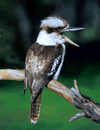
Taxonomists are scientists who classify and name plants and animals. Taxonomists
attempt to group and classify similar organisms to aid communication and
understanding.
 In
the 1700s, Carolus Linnaeus (a Swedish botanist) used a two name system
which is now called "binomial nomenclature" to classify 12,000
organisms grouped according to similar characteristics. This means that,
when told that Cygnus atratus is a bird , everyone instantly knows
it has feathers, is warm-blooded, and has a four-chambered heart like
all birds.
In
the 1700s, Carolus Linnaeus (a Swedish botanist) used a two name system
which is now called "binomial nomenclature" to classify 12,000
organisms grouped according to similar characteristics. This means that,
when told that Cygnus atratus is a bird , everyone instantly knows
it has feathers, is warm-blooded, and has a four-chambered heart like
all birds.
Dichotomous keys
To classify a large
collection of different objects, we look for similarities and group them
into increasingly smaller groups which share many features in common.
 A dichotomous key is a method for identifying and classifying objects,
where each feature selected to help identification requires a choice between
two alternatives.
A dichotomous key is a method for identifying and classifying objects,
where each feature selected to help identification requires a choice between
two alternatives.
As an example, let us make a dichotomous key for a class of 30 children.
- Choose a definable difference to separate them into two groups. For example, the difference can't be "big or small" (because these choices are not well enough defined, but could be "under 100 cm in height "and "100 cm or over in height")
|
||||||
|
2.
|
Choose a second definable feature and further subdivide the two groups. This feature might be different depending on whether or not it is appropriate. For example, it may not be appropriate to divide up boys further by observing whether or not they're wearing a dress or slacks! |
|
children
|
|||||||||
|
|
|||||||||
|
boys
|
girls
|
||||||||
|
|
|
||||||||
|
|||||||||
|
|||||||||
|
|||||||||
|
|||||||||
|
|||||||||
|
|||||||||
|
|||||||||
|
|||||||||
|
|||||||||
This key could be continued to separate out all the individual students.
Using this key, a visitor to the classroom could quickly work out which child was James. Similarly, the visitor would be able to work out the name of the blond, ear-ringed boy with the jumper.
Note: Some features may not be as useful as others. What happens if James gets hot and takes off his jumper? And what if Scott peroxides his hair?
Using these characteristics in this situation, James, Scott and Michael share many features in common, which may be very different from the others in the group.
The usefulness of the key depends on the features used to sub-divide the group.
colour, size, habitat, and so on are not the best features to use for living things, as these can change within an organism's lifetime.
Biologists mainly use structural characteristics as the
basis for their work of classifying, because these usually reflect a close
evolutionary relationship. For example, a red parrot has more in common
with a blue wren than with a red-backed spider.
An alternative method of recording the dichotomous key for the children
is shown below.1a.
|
|
| Copyright owned by the State of Victoria (Department of Education and Early Childhood Development). Used with Permission. |


